Introduction
In the rapidly evolving landscape of software development, the integration of DevOps practices has emerged as a critical strategy for organizations seeking to enhance collaboration, efficiency, and overall performance. This article delves into the core principles and practices of DevOps, emphasizing the significance of fostering a collaborative culture between development and operations teams.
It outlines essential steps for successful implementation, highlights the role of continuous planning, and identifies key tools that drive effective DevOps practices. By understanding these components, IT leaders can navigate the complexities of modern software delivery and position their organizations for success in an increasingly competitive environment.
As the demand for skilled DevOps professionals continues to rise, grasping these concepts is not just beneficial but essential for organizations aiming to thrive in 2024 and beyond.
Understanding DevOps: Principles and Practices
This approach symbolizes a transformative cultural and technical movement focused on enhancing cooperation between development and operations groups through devops planning. Understanding its key principles is paramount for effective implementation. These principles include:
-
Collaboration: This principle emphasizes breaking down silos between groups, enhancing communication and cooperation. As highlighted by the Accelerate DORA survey,
DevOps specialists collaborate across departments and groups, underscoring the necessity of a unified approach. The diverse workforce, with an average age of 39 years, illustrates the evolving nature of this field. -
Automation: Streamlining processes through automation significantly reduces manual errors and increases operational efficiency, which is critical as organizations face pressure to deliver high-quality software rapidly. This need for efficiency is compounded by the challenge of managing costs, as many IT teams find themselves using multiple unintegrated tools.
-
Continuous Integration and Continuous Delivery (CI/CD): CI/CD practices are essential for modern software development, facilitating frequent and reliable software releases. The continuous integration tools market, valued at $1.4 billion, illustrates the growing importance of these practices, with Jenkins capturing 46.35% of the market share. The average salary for a development and operations engineer stands at $103,571, highlighting the financial implications and attractiveness of this role in the industry.
-
Monitoring and Feedback: Robust monitoring systems are vital for gathering real-time feedback, enabling teams to refine processes and enhance software quality continually.
-
Iterative Improvement: Embracing a mindset of ongoing enhancement enables businesses to adjust rapidly to evolving needs and technologies, ensuring their processes stay pertinent and efficient.
By understanding these principles, IT leaders can successfully steer their entities in implementing collaborative development methodologies that not only improve software delivery but also align with devops planning and the newest trends influencing the sector in 2024. The demand for development and operations engineers continues to grow, as evidenced by the statistics, making it crucial for CTOs to understand the workforce dynamics and challenges in implementing these principles.
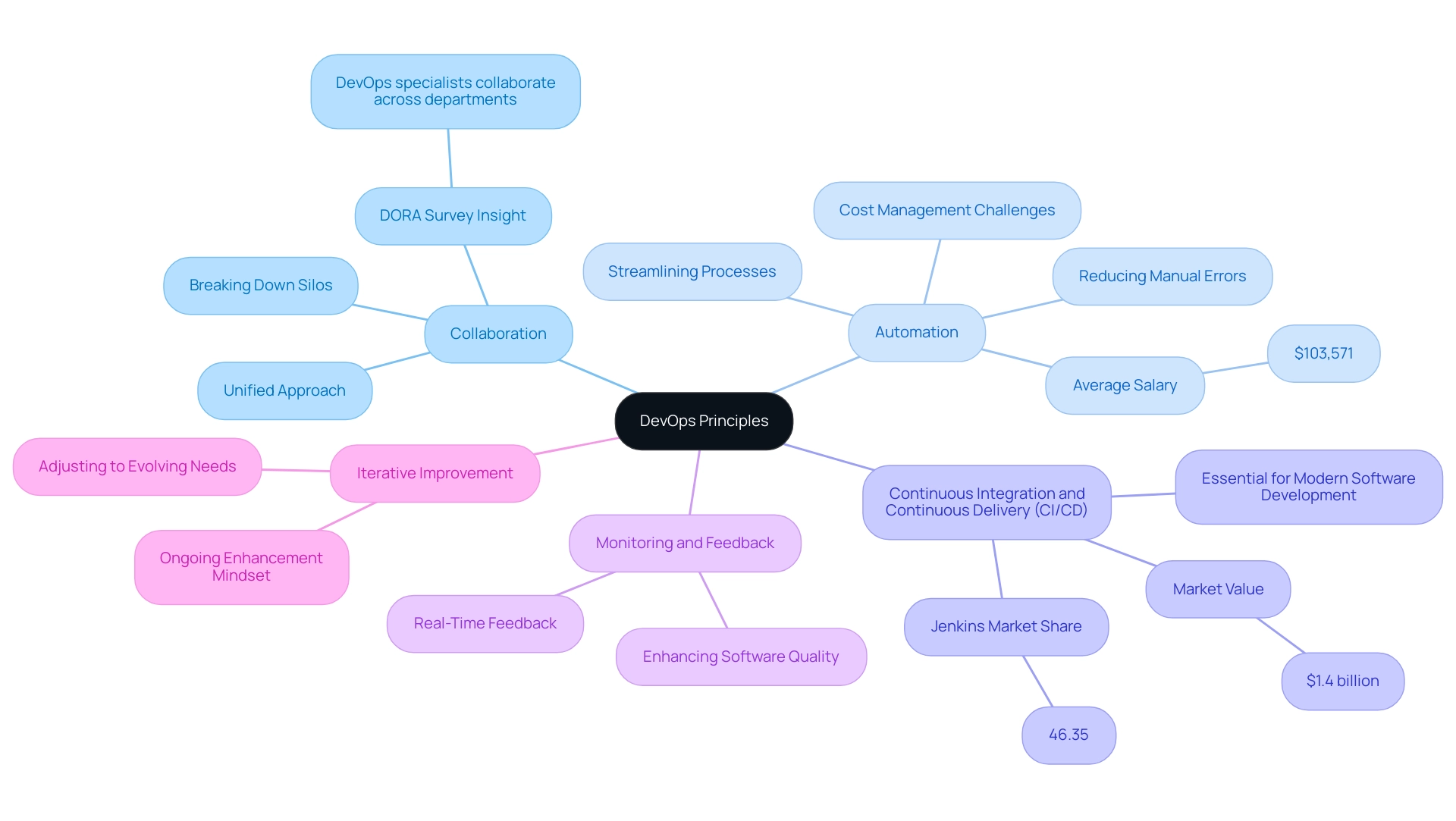
Key Steps in a Successful DevOps Implementation
To attain effective implementation of development and operations, entities should follow these essential steps:
- Assess the Current State: Begin by evaluating existing processes, resources, and team dynamics. This assessment is crucial for pinpointing areas in need of improvement, which will support effective devops planning for a tailored transformation strategy.
- Define Objectives: Clearly articulate the goals your organization aims to accomplish through devops planning. Whether it's accelerating release cycles or enhancing cross-team collaboration, defined objectives will guide subsequent efforts.
- Select the Right Instruments: Choosing the appropriate instruments is paramount. Opt for solutions that not only align with your objectives but also foster automation, monitoring, and collaborative efforts among teams. Current trends indicate that many organizations are still navigating the complexities of multiple unintegrated cloud cost management solutions, which underscores the importance of a cohesive selection process.
- Develop a Roadmap: Craft a detailed roadmap that outlines the necessary steps, timelines, and resource requirements for implementation. This strategic plan for devops planning should serve as a blueprint for guiding the transformation process.
- Pilot the Implementation: Initiate a pilot project to test the selected DevOps practices and tools in a controlled environment. This phase allows for experimentation and adjustment before a broader rollout.
- Gather Feedback and Iterate in DevOps Planning: After the pilot, it is essential to collect feedback from team members and stakeholders. This input is invaluable for refining processes and ensuring they meet the entity's needs effectively.
- Scale Up: After successfully finishing the pilot, gradually broaden practices across the company. This scaling process should be approached methodically to maintain momentum and ensure ongoing success.
Notably, 72% of entities are actively working towards unifying security with observability to effectively manage dynamic security threats. This underscores the significance of a comprehensive approach in transformation, as shown by the case study titled 'Unifying Security and Observability,' where organizations are merging security with observability and monitoring.
As Cody Slingerland succinctly puts it, 'Specialists work across departments and teams,' emphasizing that collaboration is a cornerstone of effective implementation. Additionally, considering that the average age of a DevOps Engineer is 39 years may provide valuable demographic context for CTOs when evaluating their workforce involved in development and operations.
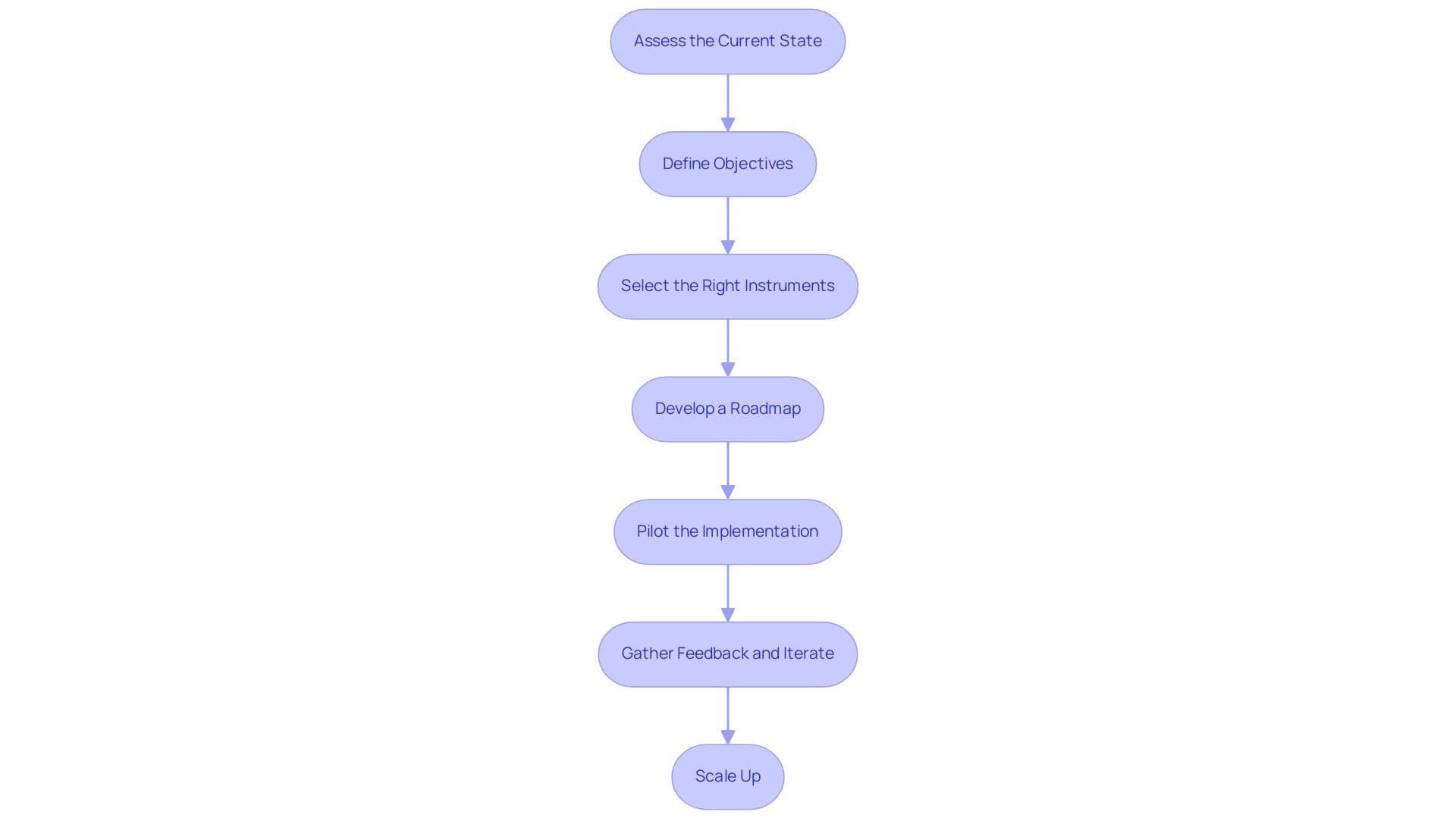
The Role of Continuous Planning in DevOps
In the domain of software development and operations, devops planning is essential for fostering an adaptive and responsive environment. It involves regularly revisiting and refining strategies based on real-time data and feedback. Key components of effective continuous planning include:
- Regular Review Meetings: Conducting frequent check-ins is crucial for assessing progress, identifying challenges, and realigning priorities as necessary.
- Data-Driven Decision Making: Leveraging metrics and stakeholder feedback is vital to inform planning choices, ensuring that strategies align closely with overarching business objectives. This method is becoming more significant, particularly as over half of the surveyed groups employ practices for deploying containers.
- Flexibility and Adaptability: Fostering an environment that welcomes change enables groups to adjust swiftly in reaction to new information or evolving market requirements, a necessity in today’s fast-paced technological landscape.
- Cross-Functional Collaboration: Involving all pertinent stakeholders in planning conversations guarantees a variety of viewpoints and insights, as emphasized by Cody Slingerland, who remarks,
specialists operate across departments and teams.
However, organizations must also navigate significant challenges in implementing continuous planning.
Cultural resistance, faced by 45% of technology leaders, can hinder progress, and the necessity for smooth integration of various resources and technologies demands careful planning and ongoing monitoring. Furthermore, grasping the demographic context can be advantageous; the typical age of a software engineering professional is 39 years, which may affect team dynamics and viewpoints.
A case study on enhanced productivity in teams illustrates the practical application of ongoing planning, demonstrating how groups emphasize maximizing the value of their instruments to automate repetitive tasks, enabling them to focus on more significant aspects of development. By prioritizing devops planning, entities can significantly enhance their agility and responsiveness. This shift not only results in better alignment with business objectives but also fosters more successful outcomes in initiatives, especially as organizations encounter challenges like cultural resistance and the necessity for smooth integration of resources and technologies.
The importance of continuous planning will only increase as organizations strive to implement Continuous Everything in 2024.
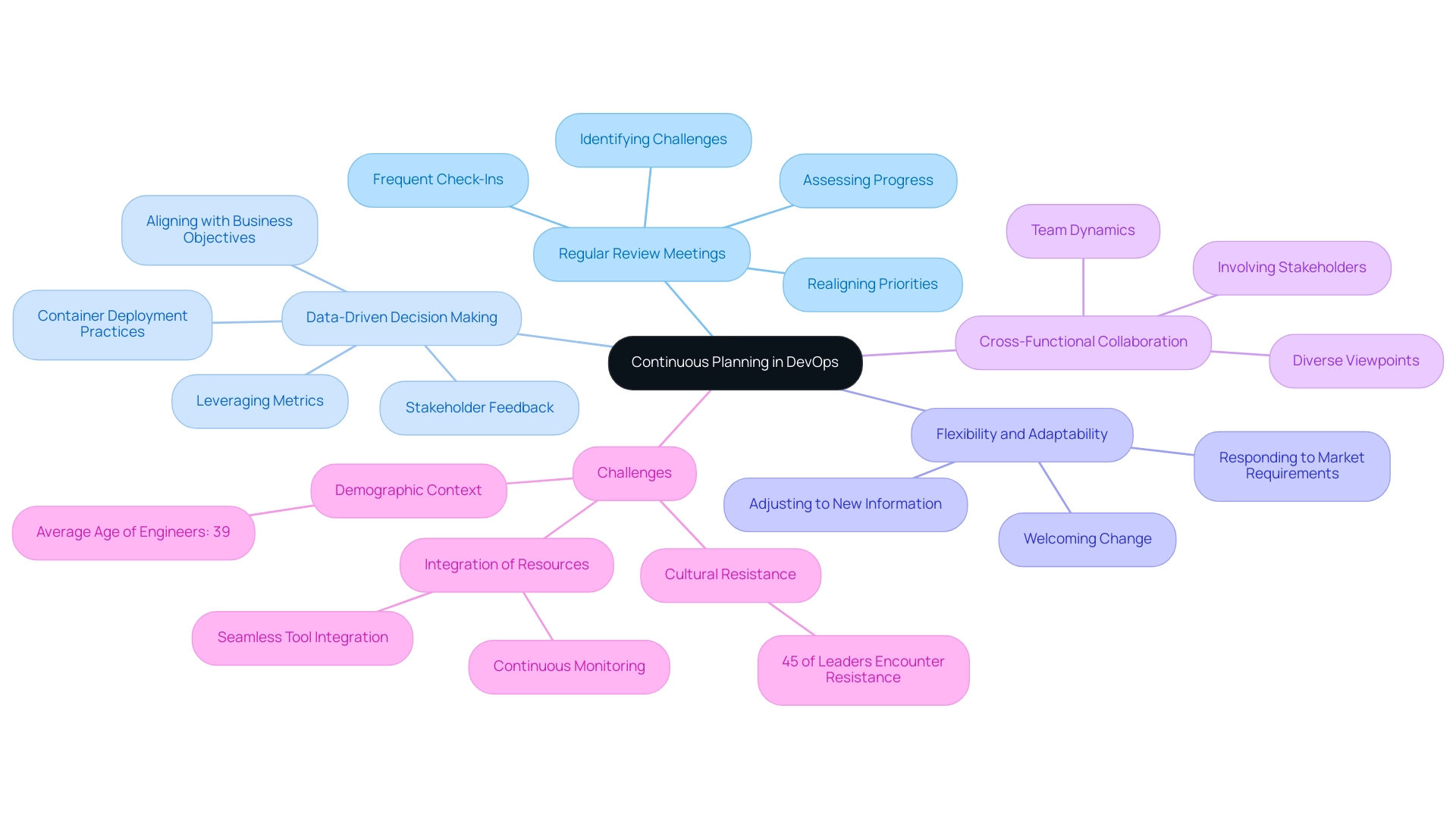
Essential Tools for Effective DevOps Planning
Successful planning in software development relies on the strategic choice of vital resources that optimize processes and improve collaboration. The following tools are fundamental to achieving robust DevOps practices in 2024:
-
Version Control Systems: Tools such as Git are essential for groups aiming to collaboratively manage code changes and meticulously track revisions, fostering a culture of accountability and transparency.
-
Continuous Integration/Continuous Deployment (CI/CD) Tools: Platforms like Jenkins, CircleCI, and GitLab CI automate the testing and deployment of code changes, significantly accelerating development cycles. Notably, organizations utilizing CI/CD systems have reported enhancements in deployment frequency and lead time for changes, underscoring their critical role in modern software development. For instance, GitLab covers the entire software development life cycle, from project planning and source code management to CI/CD, monitoring, and security, thereby reducing cycle time and increasing the speed of development.
-
Configuration Management Tools: Solutions like Ansible, Puppet, and Chef automate the setup and management of infrastructure, ensuring consistency and reducing the risk of configuration drift. This automation is vital for maintaining operational efficiency and reliability.
-
Monitoring and Logging Tools: Tools such as Prometheus, Grafana, and Splunk provide essential insights into system performance, allowing groups to proactively identify and address potential issues in real-time. These tools are essential for maintaining system health and ensuring optimal user experiences.
-
Collaboration Tools: Platforms like Slack, Microsoft Teams, and Jira enhance communication and project management among team members, facilitating seamless collaboration across dispersed teams. Their integration within the development and operations ecosystem is paramount for ensuring alignment and efficiency.
By thoughtfully selecting the appropriate combination of these resources, customized to address your entity's unique requirements, you can greatly enhance your DevOps planning and execution efforts. As emphasized by industry statistics, 68% of IT teams currently have an upskilling program in place, indicating a broader commitment to embracing advanced development and operations practices. Additionally, the use of CI/CD resources has seen a remarkable rise, with many organizations reporting up to a 68% implementation rate in their upskilling programs since 2020.
This trend ultimately leads to improved software delivery and operational performance.
In the context of effective DevOps practices, consider CloudRepo, which is utilized for managing, sharing, and distributing private Maven and Python repositories. It guarantees high availability by storing repositories across various servers and integrates effortlessly with all major CI systems. This real-world application exemplifies the importance of having strong resources in place.
As Adela Belin, a content marketer and blogger, states, "I am passionate about sharing stories with the hope of making a difference in people's lives and contributing to their personal and professional growth." This sentiment aligns with the importance of development and operations tools, as they play a vital role in assisting entities in reaching their objectives and fostering transformation.
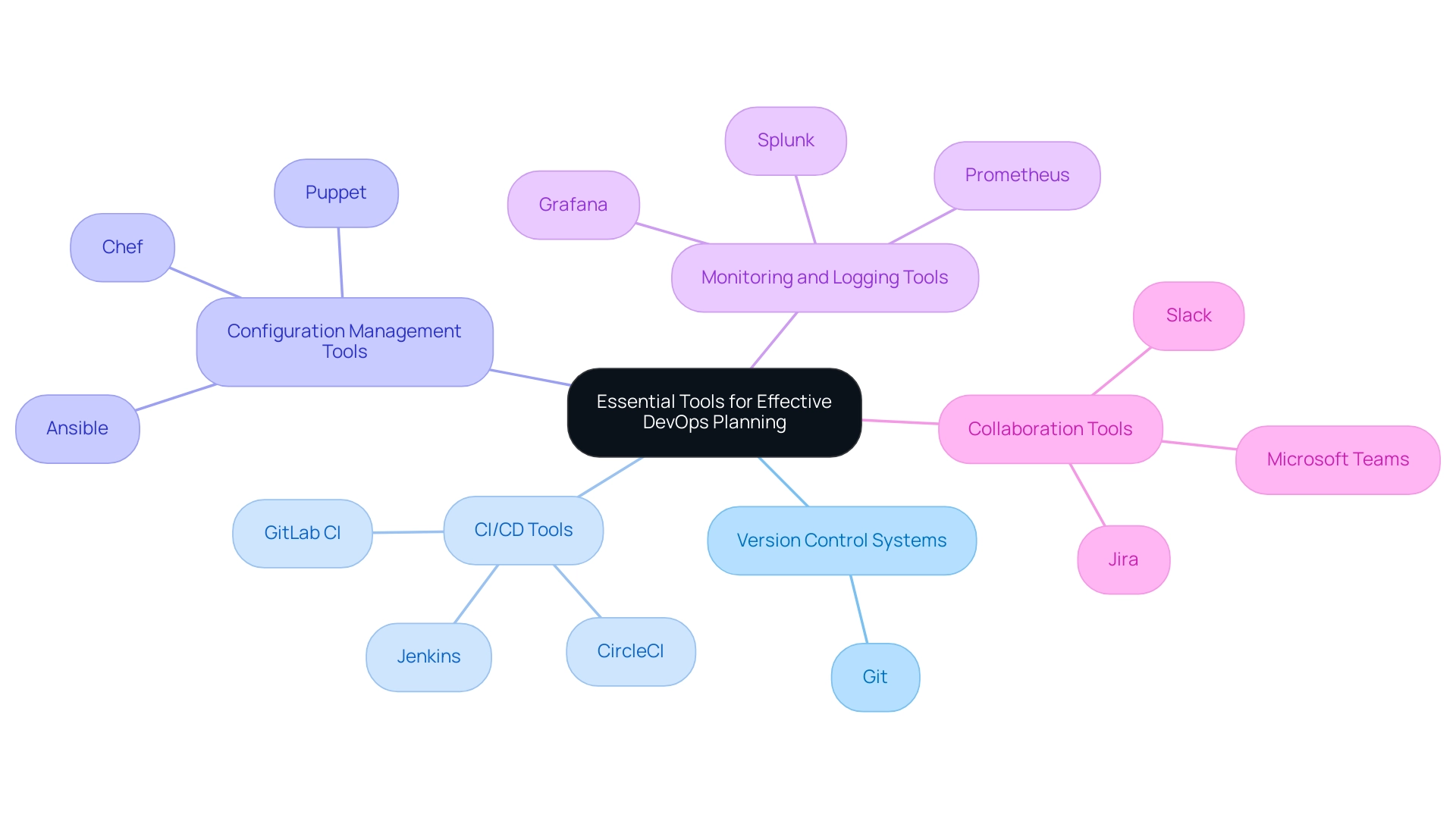
Building a Collaborative DevOps Culture
To cultivate a collaborative DevOps culture, organizations should implement the following strategies:
- Encourage Open Communication: Establish a culture where group members feel empowered to share their ideas and constructive feedback. Open dialogue is essential for fostering innovation and resolving challenges swiftly.
- Define Roles and Responsibilities: Clearly delineating the roles of each group member promotes accountability and enhances collaborative efforts. This clarity ensures that everyone understands their contributions and how they fit into the larger group objectives.
- Promote Cross-Training: Encouraging group members to gain insights into each other’s roles fosters understanding and cooperation. This practice not only enhances skill sets but also builds empathy among group members, which is crucial for effective collaboration.
- Celebrate Successes: Acknowledging and celebrating group achievements boosts morale and reinforces the value of collaboration. Celebrations can range from informal shout-outs in meetings to structured recognition programs, all of which contribute to a positive team atmosphere.
- Invest in Team-Building Activities: Organizing activities designed to strengthen bonds and foster collaboration is vital. These activities can take various forms, from workshops aimed at improving communication skills to social events that encourage personal connections.
By emphasizing a cooperative environment, companies can greatly enhance their DevOps planning efforts. Research indicates that 85% of organizations reported positive impacts on software security due to DevOps planning practices adopted in 2022. Furthermore, as Cody Slingerland, a FinOps certified practitioner, states, "With CloudZero, Drift is saving $2.4 million annually on AWS costs," showcasing the financial benefits of effective DevOps practices.
The CloudZero case study illustrates how successful cloud cost management can be achieved through collaboration, reinforcing that fostering a collaborative environment not only leads to improved project outcomes but also results in a more engaged and motivated workforce, ultimately driving success in 2024 and beyond.
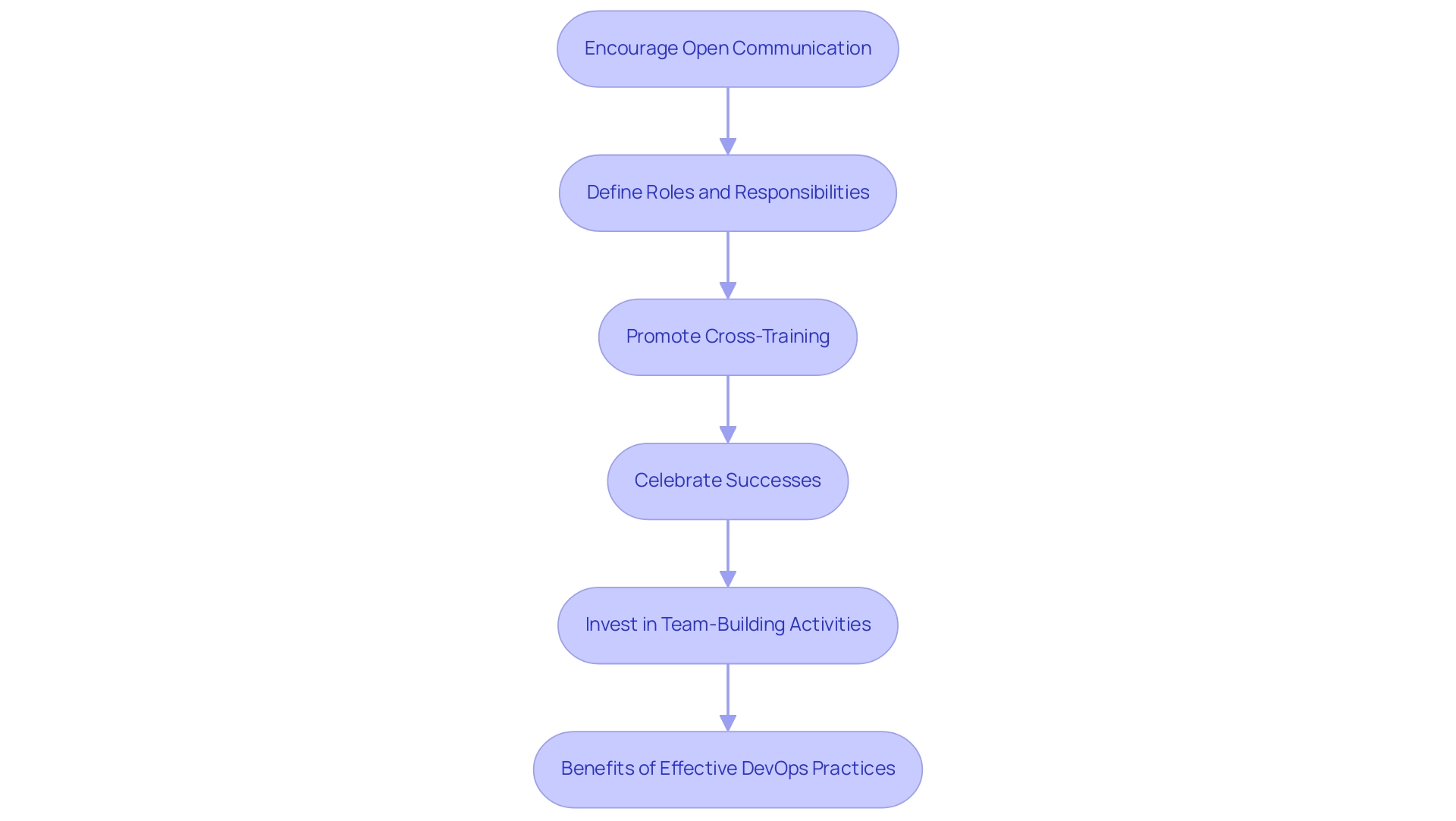
Conclusion
The integration of DevOps practices is essential for organizations looking to enhance collaboration, efficiency, and performance in software development. By understanding and implementing core principles such as:
- Collaboration
- Automation
- Continuous integration and delivery
- Monitoring
- Iterative improvement
IT leaders can effectively navigate the complexities of modern software delivery. These principles not only streamline processes but also foster a culture that embraces adaptability and responsiveness.
Successful DevOps implementation requires a strategic approach, including:
- Assessing the current state
- Defining objectives
- Selecting the right tools
- Developing a detailed roadmap
Engaging in pilot projects and gathering feedback are critical steps that enable organizations to refine their practices before scaling up. The importance of continuous planning cannot be overstated, as it allows teams to remain agile and aligned with business goals, especially as the demand for skilled DevOps professionals continues to grow.
Moreover, the selection of essential tools, such as version control systems, CI/CD platforms, and monitoring solutions, plays a pivotal role in facilitating effective DevOps practices. These tools not only enhance collaboration among teams but also improve overall operational efficiency and software delivery timelines. Building a collaborative culture through open communication, defined roles, and team-building activities further strengthens the foundation for successful DevOps initiatives.
In conclusion, as organizations strive to thrive in an increasingly competitive landscape, embracing DevOps is not just advantageous but imperative. The collective impact of adopting these practices will lead to heightened productivity, improved software quality, and ultimately, a more resilient and innovative organization ready to meet the challenges of 2024 and beyond.




